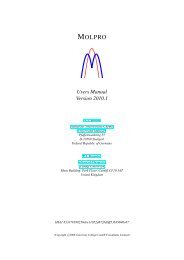Carbon−Carbon Coupling Reactions Catalyzed by Heterogeneous ...
Carbon−Carbon Coupling Reactions Catalyzed by Heterogeneous ...
Carbon−Carbon Coupling Reactions Catalyzed by Heterogeneous ...
You also want an ePaper? Increase the reach of your titles
YUMPU automatically turns print PDFs into web optimized ePapers that Google loves.
<strong>Heterogeneous</strong> Pd <strong>Catalyzed</strong> C−C <strong>Coupling</strong> <strong>Reactions</strong> Chemical Reviews, 2007, Vol. 107, No. 1 137<br />
to the original support (re-deposition) but also to other<br />
supports added to the mixture, or the dissolved species can<br />
precipitate as free Pd particles. 38 Naturally the re-deposited<br />
Pd exhibits different properties due to crystallite growth as<br />
compared with the starting Pd system, and thus normally<br />
the catalytic activity drops after each run when the material<br />
is used several times. 28,50 As another effect, re-deposited Pd<br />
can catalyze unwanted side reactions, while only the dissolved<br />
Pd supports the envisaged cross-coupling. 11,28<br />
2. Suzuki <strong>Reactions</strong><br />
2.1. Pd on Carbon (Pd/C)<br />
The Suzuki-Miyaura reaction has become a mainstay of<br />
modern synthetic organic chemistry for the preparation of<br />
biaryl compounds. 89-91 In the past decade, the Pd/C-catalyzed<br />
arylation <strong>by</strong> Suzuki-Miyaura reaction has been applied<br />
widely in organic synthesis of biaryl compounds, which can<br />
also be heterocyclic. It can further be used in coupling of<br />
various organic moieties different from aryl compounds, such<br />
as alkenes, alkynes, or alkanes. The first example of Pd/Ccatalyzed<br />
Suzuki reaction was reported <strong>by</strong> Marck and coworkers<br />
in 1994. 92 In general, Pd/C is used with or without<br />
additional phosphine ligands, and often the application of<br />
aqueous solvents is advantageous.<br />
2.1.1. In the Presence of Phosphine Ligands<br />
In the first examples of the application of Pd/C in Suzuki-<br />
Miyaura couplings (Scheme 2), triphenylphosphine was used<br />
as a ligand adopting the methodology from homogeneous<br />
catalysis. 3 The bromoarene 1 and the triflate 3 were<br />
transformed into the corresponding diaryl products 2 and 4<br />
in high yields. 92<br />
Scheme 2. Pd/C-<strong>Catalyzed</strong> Suzuki <strong>Coupling</strong> in the Presence<br />
of PPh3<br />
Nishida and co-workers 59 found that a phosphine ligand<br />
was indispensable for the Pd/C-catalyzed Suzuki reactions<br />
of halopyridines and haloquinolines in most cases (Table 1).<br />
The reactions of bromopyridines 5a-c, 2-chloropyridine<br />
(5g), 2-chloropyridines with an electron-withdrawing group<br />
5d-f, 5h, and 5i, and haloquinoline 7a and 7b proceeded<br />
smoothly and gave the products in good yields (Table 1,<br />
entries 1-9, 14, 15, and 17). However, the reactions of<br />
2-chloropyridines with an electron-donating group, 5j and<br />
5k, gave unsatisfactory results (Table 1, entries 10 and 11).<br />
The reactivity of the substrate showed the same tendency as<br />
was seen in the reaction with a homogeneous catalyst; that<br />
is, chloropyridines with an electron-withdrawing group were<br />
more reactive than those with an electron-donating group.<br />
In order to improve the yields of less-reactive substrates<br />
such as 3-chloropyridine (5l), 4-chloropyridine (5m), and<br />
6-chloroquinoline (7c), ligand effects were studied <strong>by</strong> using<br />
Table 1. Pd/C-<strong>Catalyzed</strong> Suzuki <strong>Coupling</strong> of N-Heterocycles 5,<br />
7, or 8 with PPh3<br />
entry haloheterocycle ligand yield a (%)<br />
1 5a: R) H, X ) 2-Br PPh3 85<br />
2 5b: R) H, X ) 3-Br PPh3 90<br />
3 5c: R) H, X ) 4-Br b PPh3 60<br />
4 5d: R) 3-NO2,X) 2-Cl PPh3 94<br />
5 5e: R) 5-CN, X ) 2-Cl PPh3 90<br />
6 5f: R) 5- NO2,X) 2-Cl PPh3 85<br />
7 5g: R) H, X ) 2-Cl none 0<br />
PPh3 82<br />
8 5h: R) 3-CN, X ) 2-Cl none 16<br />
PPh3 100<br />
9 5i: R) 5-CF3,X) 2-Cl none 30<br />
PPh3 85<br />
10 5j: R) 6-OMe, X ) 2-Cl PPh3 25<br />
11 5k: R) 3-NH2,X) 2-Cl PPh3 19<br />
12 5l: R) H, X ) 3-Cl PPh3 2<br />
13 5m: R) H, X ) 4-Clb PPh3 9<br />
14 7a: X) 2-Cl none 0<br />
PPh3 91<br />
15 7b: X) 3-Br none 0<br />
PPh3 91<br />
16 7c: X) 6-Cl PPh3 0<br />
17 8 none 36<br />
PPh3 72<br />
a Isolated yield. b Pyridinium hydrochloride was used.<br />
3-chloropyridine (5l) and Pd/C. The sterically hindered<br />
2-(dicyclohexylphosphino)biphenyl 12 (9 mol %) was found<br />
to improve the yield dramatically (Table 2, compare entries<br />
1 and 3). 59,93 It has been reported that bulky and electronrich<br />
ligands increase the yields of homogeneous Suzuki-<br />
Miyaura and other coupling reactions. 91 These ligands<br />
facilitate oxidative addition, and the spatial bulk around the<br />
metal promotes reductive elimination. Thus, during the Pd/<br />
C-catalyzed reaction, 12 would interact with the leaching<br />
Pd and show the same effects. The combination of Pd/C and<br />
12 was also effective for the reactions of 4-chloropyridine<br />
5m and 6-chloroquinoline 7c (Table 2, entries 4 and 5). 59<br />
Remarkably, this combination was not effective in the<br />
reaction of 4-methoxychlorobenzene 11, but Pd(II)/C and<br />
12 provided high yields of the product. (Table 2, entry 6).<br />
Table 2. Pd/C-<strong>Catalyzed</strong> Suzuki <strong>Coupling</strong> of N-Heterocycles 5,<br />
7c, or 4-Methoxychlorobenzene, 11, with Different Ligands<br />
entry haloheterocycle ligand yielda (%)<br />
1 5l: R) H, X ) 3-Cl dppp 0<br />
2 5l: R) H, X ) 3-Cl dppb 0<br />
3 5l: R) H, X ) 3-Cl 12 88<br />
4 5m: R) H, X ) 4-Cl 12 92<br />
5 7c: X) 6-Cl 12 77<br />
6 11 12 80b a Isolated yield. b Pd(II)/C was used.












![Hetero [6+3] Cycloaddition of Fulvenes with N-Alkylidene Glycine ...](https://img.yumpu.com/35423358/1/190x245/hetero-6-3-cycloaddition-of-fulvenes-with-n-alkylidene-glycine-.jpg?quality=85)




